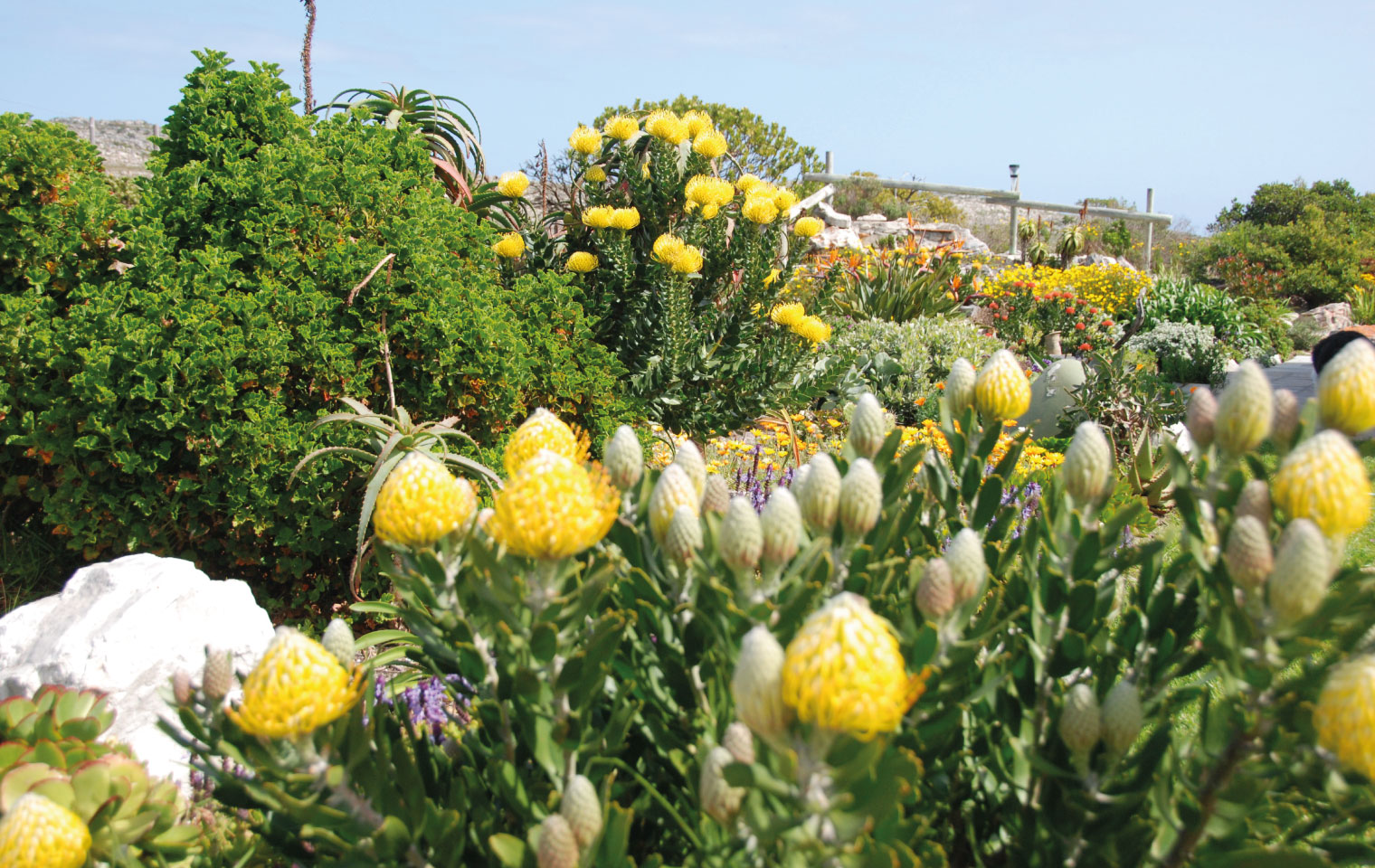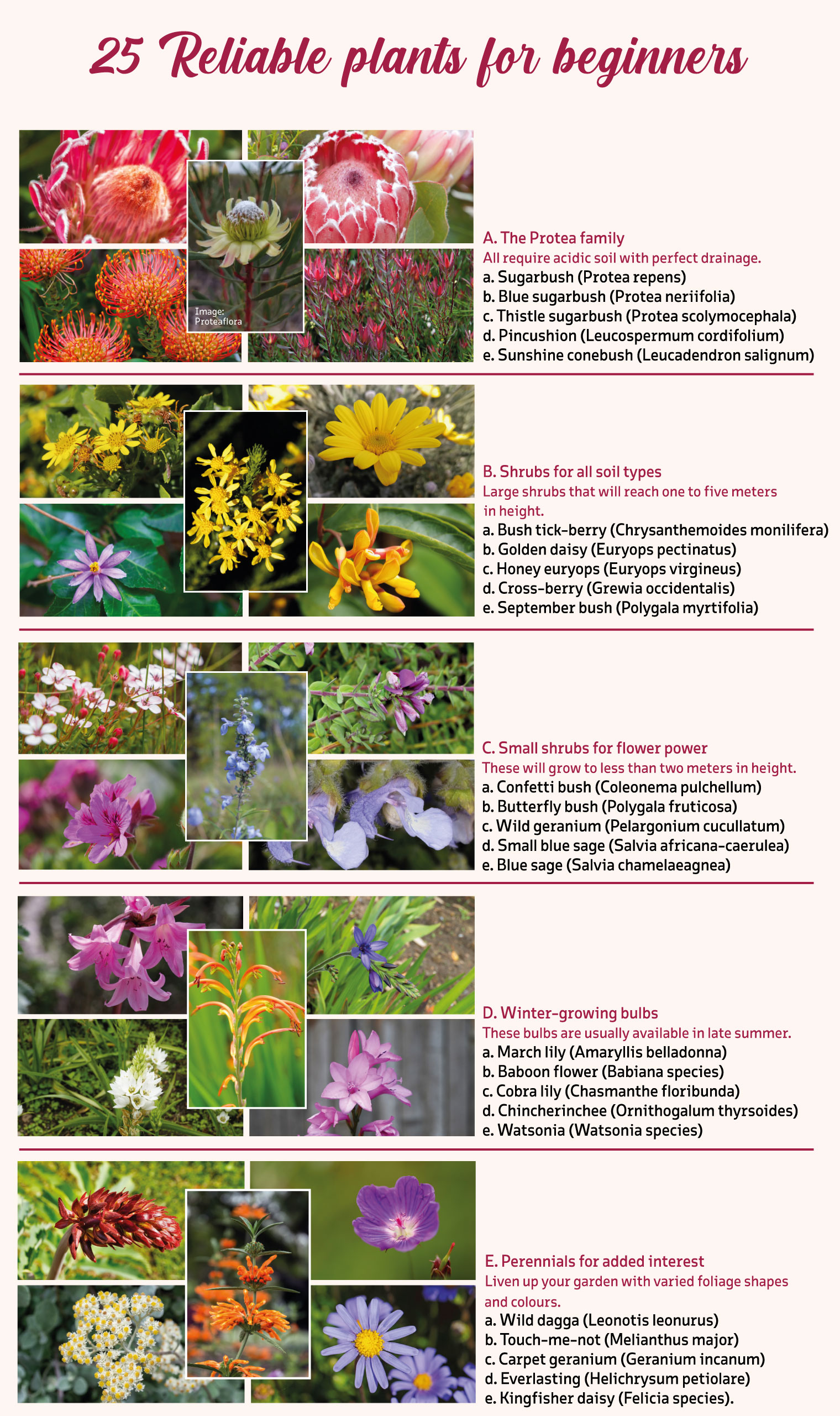Transform Your Garden with Water-Wise Fynbos
Many people have replaced thirsty plants with aloes and other succulents. But what to do if you don’t like the desert look? This month MARKtoe! presents an alternative: the fynbos garden.

WHAT IS FYNBOS?
Fynbos usually refers to a specific community of plants that includes representatives of the protea, erica and restio families, as well as bulbs. Although fynbos occurs on different soil types, individual plants tend to be picky about their requirements.
Fynbos has adapted to and thrives on long dry summers and wet winters. Your fynbos garden not only doesn’t need irrigation in summer — it doesn’t want it! Too much moisture can be deadly to the plants. Warm, wet soil is a haven for diseases that attack proteas and other fynbos species. In addition to resisting drought, the plants are able to cope with wind and to make the most of infertile soils.
Summer fires are common in the Cape. These play a vital role in the regeneration of many fynbos plants. Some are like the mythical phoenix: the mature plants are killed by the fire but the next generation literally rises from the ashes. Fire recharges the soil with essential minerals by converting old woody growth to fertilising ashes. Besides that, the seeds will only germinate after exposure to smoke.
Other fynbos plants survive fire by resprouting. These species have perennial rootstocks or corky barks that keep living tissues safe. Once the fire has passed, they rapidly produce new shoots. Resprouters respond well to pruning in the garden.
Fynbos plants are seldom long-lived. You can expect eight to 15 years for the larger shrubs and less for herbaceous perennials. But they compensate for a short lifespan by relatively fast growth. Some of the larger shrubs will reach their mature size in as little as three years. And you can look forward to flowers throughout the year — whether it rains or not.
FROM THE GROUND UP
Most fynbos plants grow in sandy, acidic soils derived from weathered quartzite sandstone. Don’t worry, you don’t have to be geologist to have a fynbos garden, but you will need to know something about your soil. If you have heavy soil like clay or silt, you will struggle with fynbos plants. Some are happy on loam, as long as there is excellent drainage. Sandy soil is best, but if it’s alkaline you should consider strandveld fynbos rather than plants from mountainous habitats. See the list of easy-growing species at the end of the article.
You can tell whether your soil is heavy by taking a handful of moist earth and squeezing it. Clay and silt form a ball that holds together, whereas loam falls apart. Sandy soil is, well, sandy — think of the beach. Telling acidic from alkaline soil is trickier. You can either buy a test kit from Agrimark, like the Makhro Soil pH Test Kit, or find a laboratory offering soil analysis.
Soil analysis may sound like a lot of hassle and not nearly as much fun as buying plants. But it can save you from costly and discouraging plant selection errors. Fynbos has many fantastic attributes, but an easy-going, forgiving attitude to soil type is not among them.
Most fynbos needs very good drainage. In fact, this applies to drought-resistant plants in general, whatever their origin. These plants survive by developing large root systems. Free-draining, open soils promote deep root growth whereas heavy, shallow soils encourage shallow roots. Shallow roots can’t sustain plants through the long, dry summer months when there is no water to be found near the soil surface.
You can tell whether you have poor drainage by digging a few test holes and filling these with water. If the hole fills quickly but the water takes hours to seep away, you have a problem. Depending on how bad the situation is, you could get away with raising the soil level a little or you may need to look at installing drains. Consult a reputable landscaper if in doubt.
DESIGN BASICS
Once you’ve determined that you have the right conditions for fynbos, you can start thinking about planting design. Be realistic about how much time and energy you have for maintenance. It can be tempting to go for instant flower-power by putting in masses of fast-growing annuals and herbaceous perennials, but trees and shrubs have more staying power. Sit down with paper and pencil and think long-term.
Trees are the dominant element in most gardens, followed by large shrubs. Fynbos trees, though few, tend to be small and suitable for anything but the tiniest garden. Most can also withstand wind. Decide on the position of trees first and then add shrubs. You can select from an amazing variety of proteas, pincushions and conebushes, as well as many others. Trees and large shrubs are the bones of your garden — they provide year-round structure and interest. They are likely to cost the most, grow the slowest and live the longest of all your plants, so choose with care.
Fynbos offers a wide array of small shrubs for your garden. Plant these in groups of three or more between and in front of the larger elements. If you’re lucky enough to have the right soil, do try growing ericas. These iconic fynbos plants come in a range of sizes, shapes and colours, all beautiful. Other fynbos favourites are restios. Even if you have ordinary garden soil, you can include small fynbos shrubs like sages and pelargoniums and enjoy months of trouble-free colour.
No garden is complete without winter-growing bulbs. The winter-rainfall areas of South Africa have a greater diversity of bulbs than any other place on earth. You can’t possibly argue that there isn’t at least one to suit your garden! Cape bulbs are dormant in the dry months and come to life in autumn. By planting a range of species, you can enjoy spectacular flowers from early autumn right through to late spring. Bulbs will return year after year and even multiply if they’re happy.
When planning your garden, short-lived flowering plants should be added last. It can be hard to resist impulse buying at the nursery when confronted with all those lovely trays of annuals and herbaceous perennials. However, keep in mind that annuals only last a few weeks, and perennials often require quite a bit of work to keep looking good. Fast growers usually need plenty of water and regular feeding.
Think of short-lived plants as the scatter cushions of the garden- best used in moderation. Having said that, flowering annuals and perennials typify late winter and early spring in the Cape. You can add them to brighten the garden and fill in gaps. Better to cover the area between new trees and shrubs with annuals than to plant too close together. For those on a tight budget, a few packets of daisy seed is a cost-effective way to inject spring colour in the garden.

CARING FOR THE FYNBOS GARDEN
The short version is: don’t. Don’t water it, don’t feed it, don’t touch it. Your fynbos garden would prefer to be left alone. The more drought-resistant a plant is, the less it likes summer irrigation. Damp, warm soil and hot humid air are a recipe for diseases, some of which can kill a mature plant within less than a day. However, keep in mind that new introductions need time to develop large root systems. Best to plant when the soil is moist and days relatively cool — in other words, right now!
The one time that watering is essential is immediately after planting. This settles the soil around the roots and removes air pockets which prevent root establishment. If the weather is very hot and dry after planting, you may want to water newbies every two to three weeks, but only for their first summer. Rake soil into a low retaining basin around the plant. The basin should be at least 60 centimetres in diameter and hold 20 to 30 litres. Fill it every two to three weeks. This forces the plant to send roots down after the water.
Fynbos plants are introverts by nature: they don’t want other plants too close and they resent disturbance. You need to find a way to control weeds without resorting to wielding a fork around your plants. The solution is mulch. Apply a generous layer of organic mulch such as bark nuggets or wood chips. This will suppress weeds as well as help retain soil moisture. Mulch also looks good and encourages wildlife.
Because fynbos has adapted and thrives on poor soils, the plants are sensitive to nutrients. Don’t give them inorganic fertilisers or rich compost like chicken mature. They will reward your efforts by dropping dead. Proteas, ericas and related plants are especially averse to feeding.
PRUNING
Pruning fynbos trees and shrubs depends on each species. As a general rule, you should remove any abnormal or dead wood. You can also improve air circulation and reduce disease risk by thinning out branches. Remove excess branches at the base.
Don’t leave stumps or snags as these are potential entry points for infection. Shrubs can be trimmed to improve the shape or control the size. Many fynbos shrubs don’t produce new growth from old wood, so always trim to above healthy leaves. If you’re not enthusiastic about pruning, remember that plants will be fine without it — no one is pruning the plants on Table Mountain.



